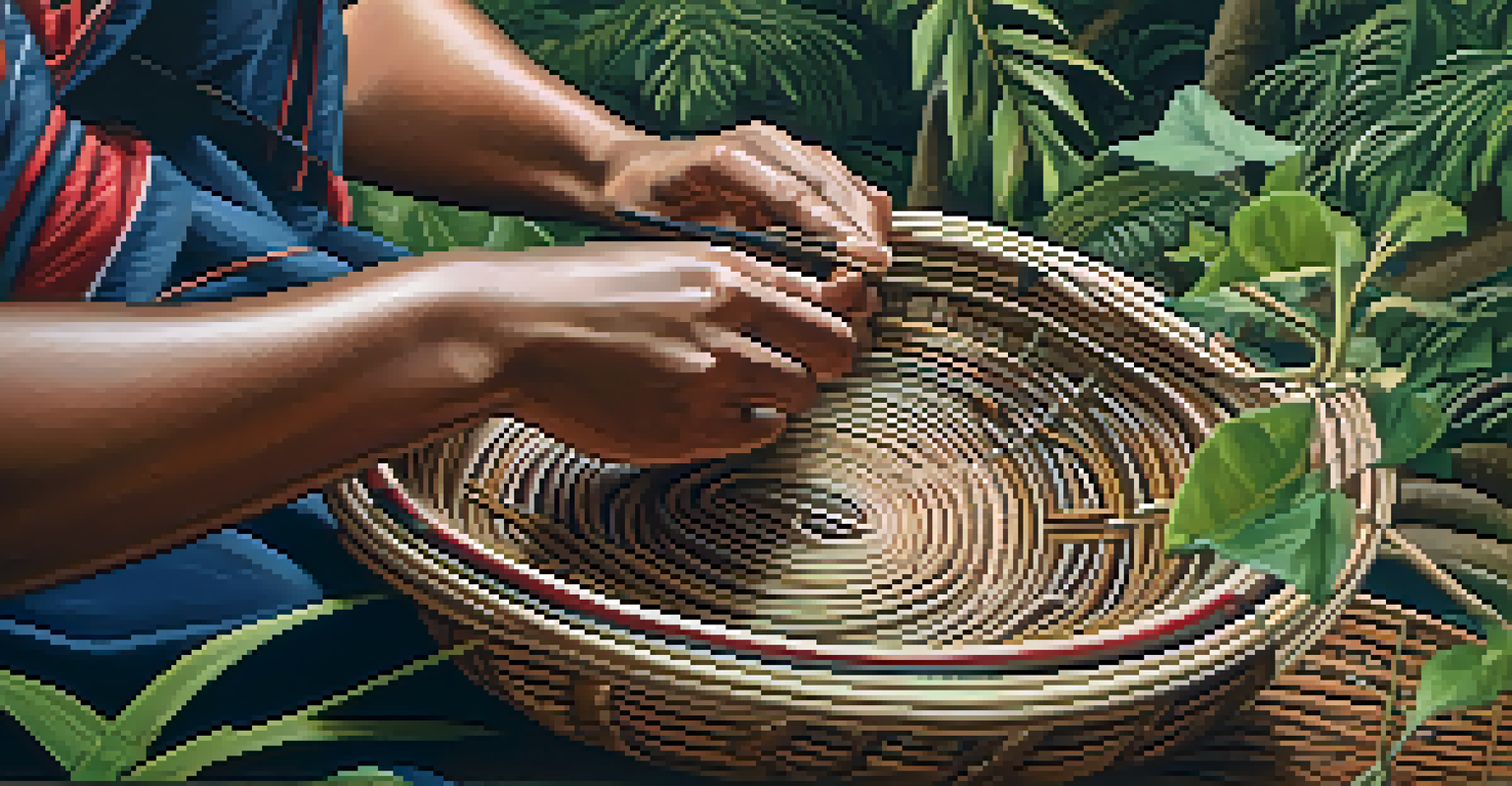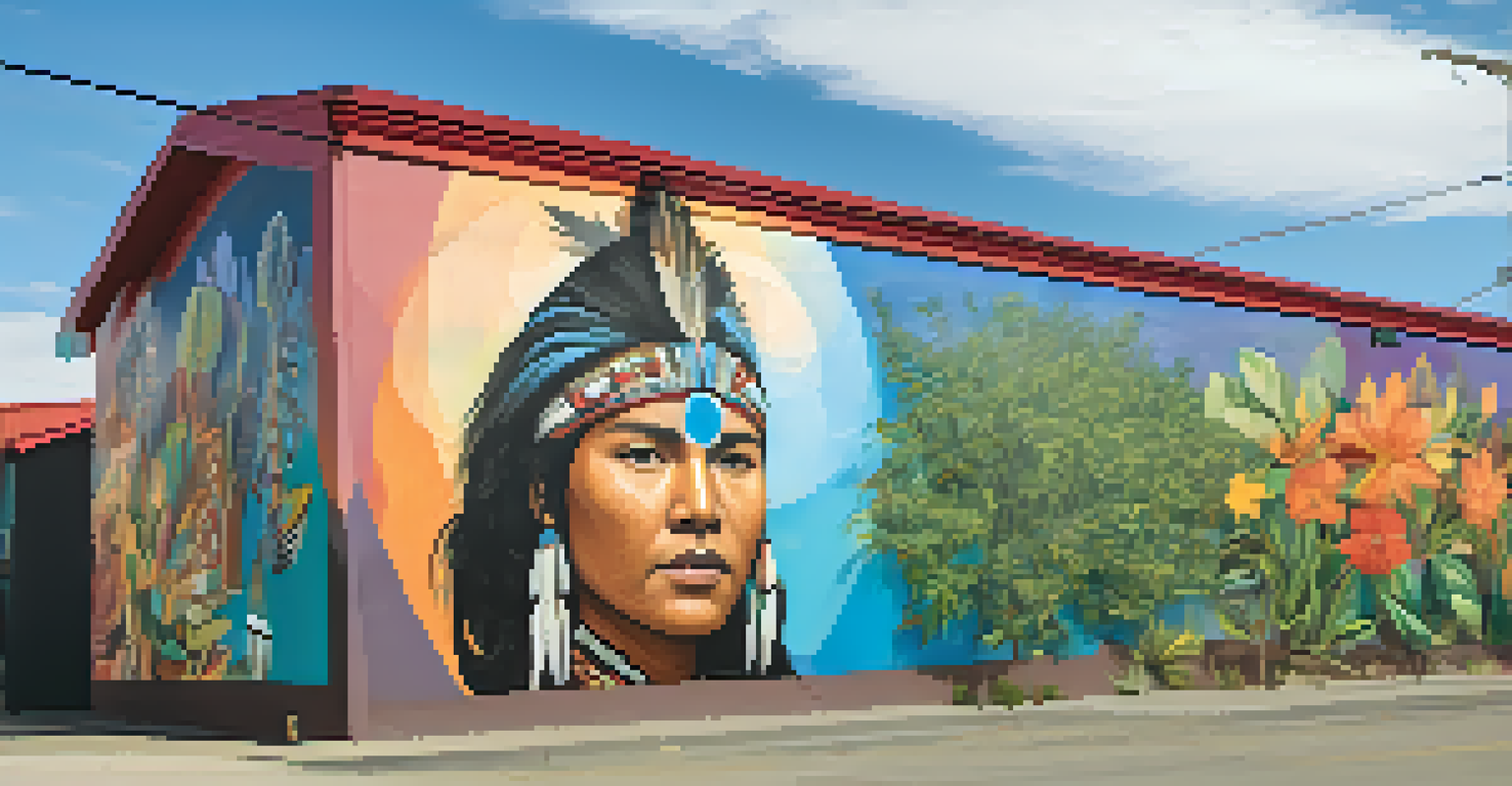Cultural Reflections: Indigenous Art and Environmental Harmony

Understanding Indigenous Art and Its Cultural Significance
Indigenous art is more than just a visual experience; it embodies the stories, traditions, and values of Indigenous peoples. Each piece reflects a deep connection to the land, showcasing cultural heritage and identity. For instance, many Indigenous artists incorporate traditional symbols and materials that tell stories of their ancestors and the natural world.
Art is a reflection of the world we live in, and it can be a powerful voice for change.
This art form often serves as a means of communication, expressing the relationship between people and their environment. It emphasizes a holistic view where nature, spirituality, and community are intertwined. By appreciating Indigenous art, we gain insight into a worldview that prioritizes harmony with the earth.
Moreover, Indigenous art resonates with contemporary environmental issues, inviting viewers to reflect on their own relationship with nature. It challenges us to consider sustainable practices and the importance of preserving cultural narratives that advocate for environmental stewardship.
The Role of Nature in Indigenous Artistic Expression
Nature is a primary inspiration for Indigenous artists, influencing their choice of materials, themes, and techniques. Many artists use natural resources, such as clay, wood, and fibers, which not only honors the environment but also reinforces their cultural practices. For example, the use of natural dyes in textiles connects the artwork to the land and seasonal cycles.

This intrinsic link to nature often results in works that highlight the beauty and fragility of ecosystems. Indigenous art frequently features local flora and fauna, reminding us of the biodiversity that surrounds us. By depicting these elements, artists celebrate their cultural landscapes while raising awareness of environmental challenges.
Indigenous Art: A Cultural Reflection
Indigenous art embodies the stories and values of Indigenous peoples, showcasing their connection to the land and cultural heritage.
Furthermore, the representation of nature in Indigenous art can evoke a sense of responsibility among audiences. Each piece encourages us to reflect on our impact on the environment and inspires a collective movement toward ecological preservation.
Indigenous Stories: Narratives of Environmental Harmony
Many Indigenous artworks tell stories that emphasize the importance of living in harmony with the environment. These narratives often include lessons passed down through generations, illustrating the consequences of neglecting nature. For example, creation stories may depict the balance between human needs and the earth's resources, serving as reminders of our interconnectedness.
Indigenous peoples have a lot to teach us about sustainable living and the interconnectedness of all life.
These stories are not just historical; they remain relevant in today's context, especially as we face pressing environmental issues. By engaging with these narratives, we can learn valuable lessons about sustainability and respect for the natural world. They encourage us to adopt practices that prioritize ecological balance, such as permaculture and community gardening.
Ultimately, Indigenous storytelling through art fosters a deeper understanding of the earth's ecosystems. It invites us to listen, reflect, and act in ways that honor both cultural heritage and environmental conservation.
Contemporary Indigenous Art: Bridging Tradition and Innovation
Today, many Indigenous artists are blending traditional techniques with contemporary styles to address modern issues. This fusion allows them to express their cultural identities while engaging a wider audience. For example, some artists might use digital mediums to reinterpret traditional motifs, making their work more accessible in the digital age.
Contemporary Indigenous art often tackles pressing social and environmental themes, such as climate change and land rights. By using their platforms, these artists amplify Indigenous voices and advocate for environmental justice. Their work not only preserves cultural heritage but also challenges societal norms and inspires change.
Nature's Role in Artistic Expression
Nature serves as a primary inspiration for Indigenous artists, influencing their themes and techniques while highlighting environmental fragility.
This evolution of Indigenous art reflects a dynamic dialogue between past and present. It showcases the adaptability of Indigenous culture and its ongoing relevance in addressing today’s ecological challenges.
Community Engagement: Art as a Tool for Environmental Advocacy
Indigenous artists often engage their communities through collaborative projects that promote environmental awareness. These initiatives can take many forms, including workshops, exhibitions, and public installations. By involving community members, artists foster a collective sense of responsibility towards the environment.
For instance, community art projects may focus on local ecosystems, encouraging participants to explore their surroundings and understand their ecological significance. This hands-on approach not only educates but also strengthens community bonds, as participants share their knowledge and experiences.
Art becomes a powerful tool for advocacy, empowering communities to voice their concerns about environmental issues. Through collaboration, Indigenous art helps to build resilience and inspires collective action toward a sustainable future.
Challenges Facing Indigenous Artists in Environmental Discourse
While Indigenous art plays a crucial role in environmental advocacy, artists face several challenges in the contemporary landscape. Issues such as cultural appropriation and misrepresentation can undermine the authenticity of their work. When non-Indigenous individuals appropriate Indigenous art, it often strips away its cultural significance and messages.
Additionally, Indigenous artists may struggle for visibility in mainstream art markets, which can limit their ability to share their environmental messages widely. Inadequate representation in galleries and institutions can lead to a lack of understanding about the importance of their work in the broader context of ecological sustainability.
Art as Advocacy for Sustainability
Indigenous artists use their work to engage communities in environmental advocacy, promoting collective responsibility and action towards sustainability.
Despite these challenges, Indigenous artists continue to persevere, using their art as a means of resistance and advocacy. By raising awareness of these issues, we can support Indigenous voices and promote a more inclusive narrative around environmental harmony.
The Future of Indigenous Art and Environmental Sustainability
Looking ahead, the future of Indigenous art is intertwined with the ongoing conversation about environmental sustainability. As more people recognize the importance of Indigenous knowledge systems, artists may find new opportunities to share their insights. This shift could lead to greater collaboration between Indigenous and non-Indigenous communities, fostering mutual respect and understanding.
Moreover, as climate change continues to impact ecosystems worldwide, Indigenous art can serve as a powerful medium for raising awareness and inspiring action. By highlighting stories of resilience and adaptation, Indigenous artists can motivate audiences to embrace sustainable practices in their own lives.

Ultimately, the future of Indigenous art reflects a hopeful vision where cultural heritage and environmental stewardship coexist. By honoring Indigenous perspectives, we pave the way for a more sustainable and harmonious relationship with the earth.